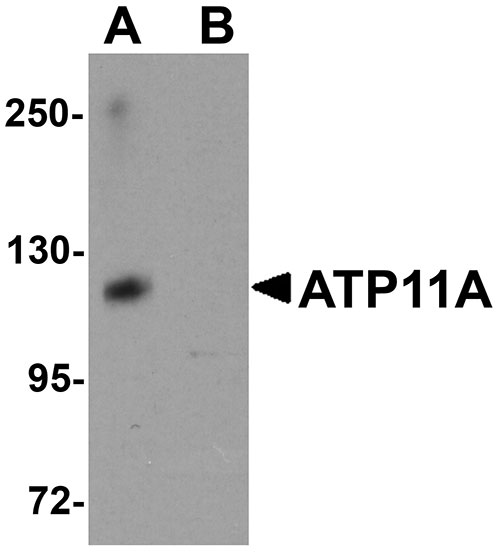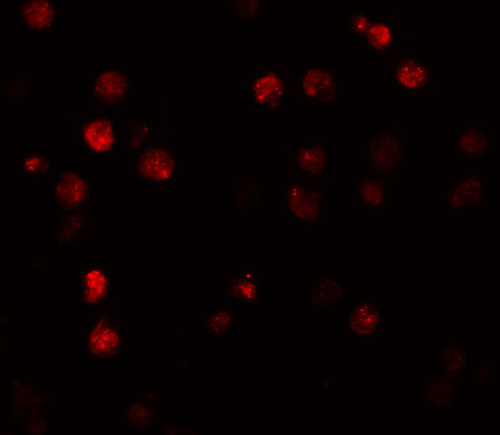ATP11A Antibody
- SPECIFICATION
- CITATIONS: 1
- PROTOCOLS
- BACKGROUND

Application
| WB, IF, ICC, E |
|---|---|
| Primary Accession | P98196 |
| Other Accession | NP_115565, 150421681 |
| Reactivity | Human, Mouse, Rat |
| Host | Rabbit |
| Clonality | Polyclonal |
| Isotype | IgG |
| Calculated MW | 129756 Da |
| Application Notes | ATP11A antibody can be used for detection of ATP11A by Western blot at 1 µg/mL. Antibody can also be used for immunocytochemistry starting at 10 µg/mL. For immunofluorescence start at 20 µg/mL. |
| Gene ID | 23250 |
|---|---|
| Target/Specificity | ATP11A; |
| Reconstitution & Storage | ATP11A antibody can be stored at 4℃ for three months and -20℃, stable for up to one year. As with all antibodies care should be taken to avoid repeated freeze thaw cycles. Antibodies should not be exposed to prolonged high temperatures. |
| Precautions | ATP11A Antibody is for research use only and not for use in diagnostic or therapeutic procedures. |
| Name | ATP11A |
|---|---|
| Synonyms | ATPIH, ATPIS, KIAA1021 |
| Function | Catalytic component of a P4-ATPase flippase complex which catalyzes the hydrolysis of ATP coupled to the transport of aminophospholipids, phosphatidylserines (PS) and phosphatidylethanolamines (PE), from the outer to the inner leaflet of the plasma membrane (PubMed:25315773, PubMed:25947375, PubMed:26567335, PubMed:29799007, PubMed:30018401, PubMed:36300302). Does not show flippase activity toward phosphatidylcholine (PC) (PubMed:34403372). Contributes to the maintenance of membrane lipid asymmetry with a specific role in morphogenesis of muscle cells. In myoblasts, mediates PS enrichment at the inner leaflet of plasma membrane, triggering PIEZO1-dependent Ca2+ influx and Rho GTPases signal transduction, subsequently leading to the assembly of cortical actomyosin fibers and myotube formation (PubMed:29799007). May be involved in the uptake of farnesyltransferase inhibitor drugs, such as lonafarnib. |
| Cellular Location | Cell membrane; Multi-pass membrane protein. Early endosome. Recycling endosome. Endoplasmic reticulum membrane; Multi-pass membrane protein. Note=Efficient exit from the endoplasmic reticulum requires the presence of TMEM30A. |
| Tissue Location | Widely expressed (PubMed:26567335). Expressed in myoblasts (PubMed:29799007). |

Provided below are standard protocols that you may find useful for product applications.
Background
ATP11A Antibody: ATP11A is a widely expressed integral membrane ATPase. ATP11A is probably phosphorylated in its intermediate state and likely drives the transport of ions such as calcium or other molecules across membranes. While the exact molecule ATP11A transports is unknown, increased expression of ATP11A mRNA has been observed in murine leukemia cells made resistant to anti-cancer drugs such as farnesyltransferase inhibitors (FTIs). Furthermore, overexpression of ATP11A provided protection against the FTI SCH66336 while knockdown of ATP11A via siRNA made cells more sensitive to this drug. Other reports suggest that elevated levels of ATP11A mRNA may also be a predictive marker of metastasis in colorectal cancer patients.
References
Halleck MS, Lawler JF Jr, Blackshaw S, et al. Differential expression of putative transbilayer amphipath transporters. Physiol. Genomics1999; 1:139-50.
Zhang B, Groffen J, and Heisterkamp N. Resistance to farnesyltransferase inhibitors in Bcr/Abl-positive lymphoblastic leukemia by increased expression of a novel ABC transporter homolog ATP11a. Blood2005; 106:1355-61.
Miyoshi N, Ishii H, Mimori K, et al. SCRN1 is a novel marker for prognosis in colorectal cancer. J. Surg. Oncol.2010; 101:156-9.
If you have used an Abcepta product and would like to share how it has performed, please click on the "Submit Review" button and provide the requested information. Our staff will examine and post your review and contact you if needed.
If you have any additional inquiries please email technical services at tech@abcepta.com.














 Foundational characteristics of cancer include proliferation, angiogenesis, migration, evasion of apoptosis, and cellular immortality. Find key markers for these cellular processes and antibodies to detect them.
Foundational characteristics of cancer include proliferation, angiogenesis, migration, evasion of apoptosis, and cellular immortality. Find key markers for these cellular processes and antibodies to detect them. The SUMOplot™ Analysis Program predicts and scores sumoylation sites in your protein. SUMOylation is a post-translational modification involved in various cellular processes, such as nuclear-cytosolic transport, transcriptional regulation, apoptosis, protein stability, response to stress, and progression through the cell cycle.
The SUMOplot™ Analysis Program predicts and scores sumoylation sites in your protein. SUMOylation is a post-translational modification involved in various cellular processes, such as nuclear-cytosolic transport, transcriptional regulation, apoptosis, protein stability, response to stress, and progression through the cell cycle. The Autophagy Receptor Motif Plotter predicts and scores autophagy receptor binding sites in your protein. Identifying proteins connected to this pathway is critical to understanding the role of autophagy in physiological as well as pathological processes such as development, differentiation, neurodegenerative diseases, stress, infection, and cancer.
The Autophagy Receptor Motif Plotter predicts and scores autophagy receptor binding sites in your protein. Identifying proteins connected to this pathway is critical to understanding the role of autophagy in physiological as well as pathological processes such as development, differentiation, neurodegenerative diseases, stress, infection, and cancer.



